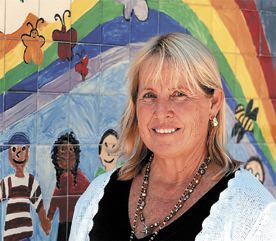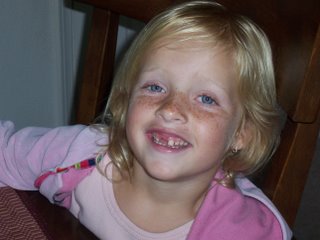Saturday, September 30, 2006
Saturday, September 16, 2006
Thursday, September 14, 2006
Friday, September 01, 2006
SB Newspress Article

LOCAL SCHOOLS GET THEIR GRADES
ROB KUZNIA, NEWS-PRESS STAFF WRITER
September 1, 2006 7:10 AM
The state released a comprehensive batch of test-score results Thursday, triggering emotions high and low across Santa Barbara County as the gains and losses of each individual school were laid bare.
For the first time ever, the state simultaneously released both the state and federal interpretations of a barrage of tests taken in the spring by students in grades 2 through 11.
It means the state this year unveiled more than just every school's academic performance index (API) -- a measure between 200 and 1,000 -- as it usually does this early on. This time, the state also released the names of schools that have been penalized by the federal government under the No Child Left Behind Act of 2001.
Although the difference between the state and federal accountability models is complex, in general, the state tracks the improvement of entire schools while the U.S. punishes schools that, by federal standards, fail to boost high enough the performance of struggling students. Neither system takes away money as a penalty or gives money as a reward.
All told, the results delivered good news to campuses including Isla Vista and Hollister elementary schools in Goleta, Santa Barbara High School and all three elementary schools in the Hope district.
But the news wasn't good for the five South Coast schools that joined the swelling ranks of those sanctioned by the federal government: Franklin and Harding elementary schools in Santa Barbara, Canalino Elementary and Carpinteria Middle in Carpinteria, and La Patera Elementary in Goleta. Nor was it good for San Marcos High, Goleta Valley Junior High and Cèsar Chávez and Monroe elementary schools, which are all one strike away from getting sanctioned by the federal government. (Schools get two strikes.)
The federal sanctions stiffen with each additional year of so-called Program Improvement. In the first year, schools must send every parent in the attendance area a humbling letter stating they may send their child to another school. In "Year 4," the school can lose its principal and staff or be converted into a charter school.
On the state accountability model, which includes the much-talked-about API scores, South Coast schools fared well.
The average score of every South Coast school district surpassed the state average API of 720. The Hope elementary district's schools averaged a whopping 900; Goleta, 804; the Santa Barbara high district, 760; the Santa Barbara elementary district, 743; and Carpinteria, 733.
The highest-scoring school in the county was Cold Spring Elementary in Montecito, with a 960; the lowest was McKenzie Junior High in Guadalupe, with a 618.
In Goleta, educators at Isla Vista Elementary School celebrated a historic occasion: The school became the first ever in Santa Barbara County to successfully climb out of No Child's sanctions. The achievement prompted a congratulatory visit by the district's superintendent.
"We've worked really hard, done a lot of introspective work -- looked at kids inside and out," Principal Lisa Maglione said. "We do not want to leave any children behind; we call it 'all children advance.' "
As a practical matter, the turnabout means the school no longer must send the disheartening letters.
Two years ago, partly in an effort to reverse the sanctions at Isla Vista, the Goleta school board granted Isla Vista and other low-income schools more money to hire more teachers. At Isla Vista, it allowed the school to better engage in small-group instruction every day for English, among other things. The practice continues.
The scores also gave Hollister Elementary cause to crow: The school surpassed the state-set target of 800 by eight points this year.
In Santa Barbara, educators at the flagship high school celebrated a historic moment of their own. For the first time in memory, Santa Barbara High School's API score surpassed that of San Marcos High. For years, Santa Barbara High has posted the lowest score of the district's three high schools.
Meanwhile, Dos Pueblos High, long considered the district's golden child, lost ground for the second consecutive year, falling from 798 to 784. But it remains the highest of the three.
At Santa Barbara High, Paul Turnbull, who took the principal post a year ago, attributed the success largely to a program that began shortly before he arrived: Struggling students are assigned to two periods of English. Affecting a full one-quarter of the school's pupils, the program -- which is expanding -- didn't come without sacrifice: The selected students cannot take elective courses such as woodshop, foreign language and music. Students can test out after one semester.
San Marcos High Principal Craig Morgan said he was disappointed by his school's drop from 749 to 741, but added that there's a chance the scores weren't calculated correctly.
"Something doesn't seem right," he said, but added that teachers already are sharpening their focus by scrutinizing the tests their kids took last year, in an effort to find weak spots.
At Harding Elementary, one of several Santa Barbara elementary schools bedeviled by an exodus of middle-class families, new principal Sally Kingston said she wasn't about to let the No Child Left Behind sanction undermine the hard work of her staff.
"The scores can be dangerous, because they oversimplify something complex," she said, adding that the staff has a plan in place to boost student performance. "Morale here is incredibly high. . . . If I could put this (morale) in a bottle and sell it, I would be a millionaire."
The No Child Left Behind Act mandates that an ever-increasing percentage of students in every subgroup -- white, Latino, poor, English learners and others -- score "proficient" in English and math. Currently, the bar is set at about 25 percent, but it rises continually and will do so until 2014, when it will hit 100 percent. Critics blast the legislation as unrealistic, saying that, by 2014, every school with enough poor students to receive federal funds will be sanctioned.
Indeed, the number of such schools spiked in Santa Barbara County this year, from 17 to 27 out of 103 public schools. The largest concentration is in the Santa Maria K-8 district, where 12 of 20 schools are being sanctioned. Three schools in the county have entered their fourth year of sanctions: La Cumbre Junior High in Santa Barbara and Fairlawn and Oakley elementary schools in Santa Maria.



